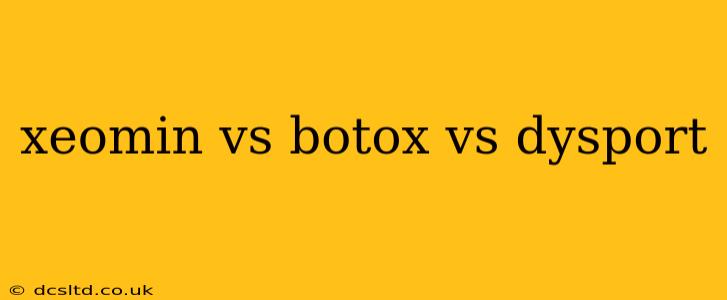Choosing between Xeomin, Botox, and Dysport can feel overwhelming. These three neuromodulators all work similarly to temporarily reduce the appearance of wrinkles by blocking nerve signals to the muscles that cause them, but they have subtle differences that might make one a better fit for you than the others. This comprehensive guide will break down the key distinctions, helping you make an informed decision with your dermatologist or cosmetic surgeon.
What are Xeomin, Botox, and Dysport?
All three—Xeomin (incobotulinumtoxinA), Botox (onabotulinumtoxinA), and Dysport (abobotulinumtoxinA)—are botulinum toxin type A injectables. They temporarily paralyze the underlying facial muscles responsible for wrinkles, leading to a smoother appearance. The key difference lies in their formulation and how their effects might manifest.
Xeomin vs. Botox vs. Dysport: Key Differences
While all three achieve similar results, variations in their protein composition and how they are processed lead to some differences:
-
Formulation: Botox and Dysport contain complex proteins in addition to the botulinum toxin. Xeomin is considered a "pure" botulinum toxin, meaning it has a simpler formulation with fewer added proteins. Some believe this simpler formulation reduces the likelihood of antibody formation, though more research is needed to definitively confirm this.
-
Onset and Duration: The onset of results and the duration of effects can vary slightly between the three. Botox typically shows noticeable results within a few days, while Dysport might take a bit longer. The duration of effects is generally similar across the three, lasting approximately 3-4 months, though individual results can vary. Xeomin’s onset and duration are generally comparable to Botox.
-
Spread: Dysport is often described as having a wider spread of action than Botox. This means that a smaller amount might be needed to treat a larger area. Xeomin’s spread is considered to be more comparable to Botox.
-
Treatment Areas: While all three are used to treat wrinkles in various areas (forehead lines, crow's feet, frown lines, etc.), some practitioners might find certain products better suited for specific treatment areas based on individual muscle anatomy and response.
What are the side effects of Xeomin, Botox, and Dysport?
The most common side effects of all three injectables are minor and temporary, including:
- Bruising: Minor bruising at the injection site is common and usually resolves within a few days.
- Swelling: Some mild swelling may occur, typically resolving quickly.
- Headache: Headaches are a relatively common side effect.
- Flu-like symptoms: Rarely, patients may experience flu-like symptoms.
More serious side effects are rare but possible and include drooping eyelids or eyebrows, difficulty swallowing, and breathing problems. These serious side effects are more likely if the injection is administered incorrectly. It's crucial to seek treatment from a qualified and experienced medical professional.
How long does Botox last?
The duration of Botox, Dysport, and Xeomin is generally similar—lasting approximately 3-4 months. However, individual responses vary depending on factors like metabolism, muscle activity, and the specific product used.
Which is best for forehead wrinkles?
The best neuromodulator for forehead wrinkles depends on individual factors and practitioner preference. All three are effective, but a doctor might choose one based on the patient's specific muscle anatomy and previous responses to these treatments.
Is Xeomin better than Botox?
Whether Xeomin is better than Botox is subjective and depends on individual responses. Xeomin's simpler formulation might be advantageous for some individuals, but clinical evidence supporting a definitive "better" option is limited. Both products are effective.
Does Dysport spread more than Botox?
Yes, Dysport generally spreads more than Botox, meaning a smaller amount might be needed to cover a larger area. This can be advantageous for treating larger areas or achieving a more diffuse effect.
What is the difference between Xeomin and Dysport?
The main difference is in their protein composition. Xeomin has a purer formulation compared to Dysport, which contains additional proteins. This difference may impact the spread and how the body responds to the treatment, although the clinical significance of these differences remains a topic of ongoing discussion among medical professionals.
Choosing the Right Neuromodulator: Consultation is Key
The best neuromodulator for you depends on individual factors, including your medical history, desired outcome, and your dermatologist's experience with these treatments. A thorough consultation with a qualified and experienced medical professional is essential to determine which option is most suitable for your specific needs and expectations. They can assess your facial anatomy, discuss your concerns and goals, and recommend the best treatment plan. Remember, the goal is a natural-looking, refreshed appearance, and a skilled injector is key to achieving that.
